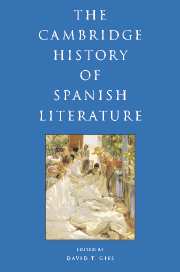Book contents
- Frontmatter
- I INTRODUCTION
- II HISTORY AND CANONICITY
- III THE MEDIEVAL PERIOD
- IV EARLY MODERN SPAIN: RENAISSANCE AND BAROQUE
- V THE ENLIGHTENMENT AND NEOCLASSICISM
- VI THE FORGING OF A NATION: THE NINETEENTH CENTURY
- 22 Romanticism in Spain
- 23 The theatre in Romantic Spain
- 24 Mariano José de Larra
- 25 Romantic poetry
- 26 Romantic prose, journalism, and costumbrismo
- 27 Benito Pérez Galdós
- 28 The Realist novel
- 29 The Naturalist novel
- 30 The theatre in Spain 1850–1900
- 31 Poetry in the second half of the nineteenth century
- VII THE MODERN, MODERNISMO, AND THE TURN OF THE CENTURY
- VIII TWENTIETH-CENTURY SPAIN AND THE CIVIL WAR
- IX IN AND OUT OF FRANCO SPAIN
- X POST-FRANCO SPANISH LITERATURE AND FILM
- Bibliography
- Index
- References
23 - The theatre in Romantic Spain
from VI - THE FORGING OF A NATION: THE NINETEENTH CENTURY
Published online by Cambridge University Press: 28 March 2008
- Frontmatter
- I INTRODUCTION
- II HISTORY AND CANONICITY
- III THE MEDIEVAL PERIOD
- IV EARLY MODERN SPAIN: RENAISSANCE AND BAROQUE
- V THE ENLIGHTENMENT AND NEOCLASSICISM
- VI THE FORGING OF A NATION: THE NINETEENTH CENTURY
- 22 Romanticism in Spain
- 23 The theatre in Romantic Spain
- 24 Mariano José de Larra
- 25 Romantic poetry
- 26 Romantic prose, journalism, and costumbrismo
- 27 Benito Pérez Galdós
- 28 The Realist novel
- 29 The Naturalist novel
- 30 The theatre in Spain 1850–1900
- 31 Poetry in the second half of the nineteenth century
- VII THE MODERN, MODERNISMO, AND THE TURN OF THE CENTURY
- VIII TWENTIETH-CENTURY SPAIN AND THE CIVIL WAR
- IX IN AND OUT OF FRANCO SPAIN
- X POST-FRANCO SPANISH LITERATURE AND FILM
- Bibliography
- Index
- References
Summary
In the 1820s, on the eve of the only sustained Spanish incursion into what was, even at the time, called “romántico,” the Spanish theatre was in a muddle. Plagued for years by administrative incompetence, financial instability, ecclesiastical and political censorship, and – in part due to the foregoing reasons – a paucity of new dramatists and quality works, the theatre subsisted on a diet of translations, melodramas, magical comedies, operas, and refundiciones (“rewritings”) of Golden Age plays. Serious plays – tragedies and comedies – were noticeably absent from the boards. Some attempts were made, of course, to take note of literary trends outside the country, but it was not until the end of the decade, and then, more rapidly following the death of King Fernando VII in 1833, that the Spanish theatre managed to stage imported or home-grown plays that reflected the collective energy and European angst called Romanticism.
Still, Romanticism in Spain was hardly an imported affair, nor would it be restricted to a narrow time period in the first half of the nineteenth century. As I. L. McClelland and Russell P. Sebold have amply demonstrated, the cosmic preoccupation with the self, the obsession with death, and man’s sense of being abandoned by greater powers revealed themselves with great clarity during the final years of the eighteenth century in Spain, particularly in the writing of Meléndez Valdés, Jovellanos, and Cadalso, whose sensitivity to the metaphors, symbols, and cosmic worries that would come to dominate Spanish literature fifty years later is now understood.
- Type
- Chapter
- Information
- The Cambridge History of Spanish Literature , pp. 350 - 361Publisher: Cambridge University PressPrint publication year: 2005

